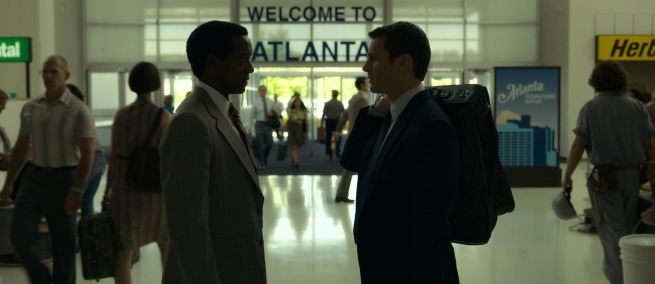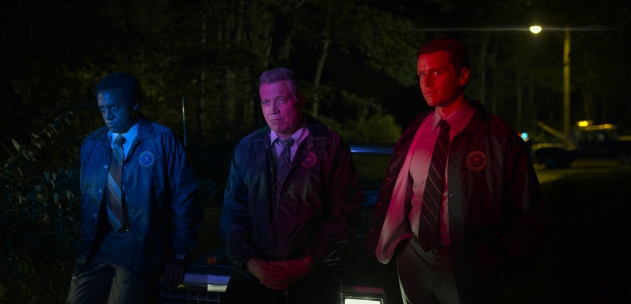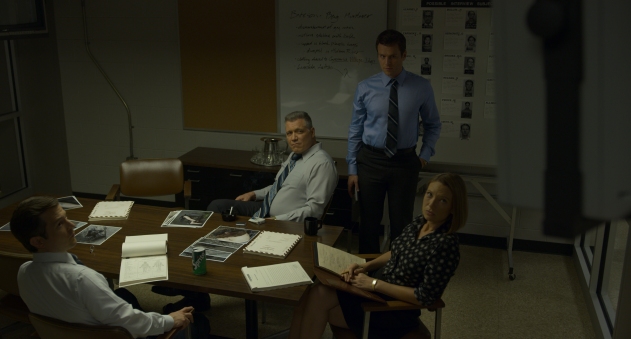
[Editor’s Note: This article is part of “Peer Review,” an ongoing series in which we commission research scientists to write about topics in current film or television. The Netflix series MINDHUNTER stars Jonathan Groff and Holt McCallany as FBI agents establishing a behavioral psychology unit to profile serial killers. The first two seasons are now streaming. We asked Brown University Professor and Director of Forensic Psychiatry at Rhode Island Hospital Dr. Wade Myers, and Brown University Forensic Psychiatry Fellow Dr. Zain Khalid to review season two of MINDHUNTER.]
The second season of Netflix’s MINDHUNTER follows FBI special agents Bill Tench (played by Holt McCallany) and Holden Ford (Jonathan Groff) as they investigate a string of child murders in Atlanta in the 1970s. The series, adapted from John E. Douglas’s book Mindhunter: Inside the FBI’s Elite Serial Crime Unit, weaves historical detail with narrative drama to canvass a rich and often nuanced account of the FBI investigation that culminated in the arrest of 23 year old African American Wayne Williams, later dubbed the “Atlanta Monster.” Much of the series’ focus is the then-novel investigative strategy of criminal profiling developed at the FBI’s Behavioral Science Unit. Here, we review the show’s depiction of offender profiling in light of current scientific evidence.
The two lead characters driving the action strike very distinct figures. Tench is a square-framed, spartan-looking, rule-abiding family man given to backyard burger-flipping and cocktail sociability. Holden Ford—who is loosely modeled on author John Douglas himself—in some ways caricatures a classic trope of American crime drama: the obsessive maverick visionary, defying the tedium of methodical sleuth-work in favor of intuition and instinct; awkward social graces and intense stares complete the picture. The profilers’ own profiles—contrasting convention with wayward genius—provide an interesting parable for the tension around investigative methodology that the series explores.

Bill Tench (Holt McCallany)
Through a hazy, sickly-yellow lens panned across suburbanizing Atlantan streets, MINDHUNTER introduces us to the slow exhaustion gripping a city in the midst of a protracted catastrophe. Atlanta in the late 1970s, as the series rightly acknowledges, was an emerging hub of the New South. A city of predominantly black residents, for the first time under a black administration, the city was eager to propel itself out of a racial history fraught with tension and into a future as a thriving metropolis that was “too busy to hate.” The murders reopened old wounds and rekindled suspicions of political and racial malice: talk of the Klan and corrupt Uncle Toms began to resurface. Much like Tench’s adopted son Brian, who we see turn mute and start to wet the bed again after he witnesses a horrific murder, we find the city regressing in the face of an all-consuming trauma.
In a scene that neatly summarizes these dire circumstances surrounding the investigation, the semi-retired and probably alcoholic detective Garland informs Holden, “we average eight to ten child murders a year here. Atlanta has the fourth highest murder rate in the country…these murders don’t represent a blip; if you’re looking for a monster, it’s poverty. These kids scrounging for pennies, family services already had files on all of them.” He also notes the historic distrust of police and a local politics complicated by a black mayor’s bid to avoid white flight and associated capital flight.
Garland’s counterpoint to Holden about the structural ‘monsters’ of class and race is not without significance, despite its seeming irrelevance to Holden. It not only helps situate the investigation and its enduring perception within a broader sociopolitical context of doubt and suspicion, but also throws into sharp relief a central anxiety for the series: are Holden’s methods any better than the kind of profiling marginalized Atlantans have been used to all their lives?

Jim Barney (Albert Jones), Bill Tench, Holden Ford (Jonathan Groff)
Holden, however, remains unfazed by these awkward realities as he draws up a controversial “profile” for the “unsub” (unknown subject) using a mix of inductive and deductive inferences. He considers the improbability of a white abductor going unnoticed in black neighborhoods; he factors in the statistical evidence against serial killers offending outside their race; he notices commonalities in victim pool—they’re all black, all poor, all children. He comes up with a suspect description: “A black male in his 20s or early 30s who drives a certain type of vehicle.” The ‘working’ of this profile, for all its unhelpful breadth and the many rabbit holes it opens up, becomes a central strategy for the investigation. Leads that don’t match the profile are dropped or only cursorily entertained. White callers claiming responsibility for the murders don’t fit the profile and so register only faintly on the investigative radar. Holden is seen fending off skepticism from his team, from the authorities, and from the victim’s families. He becomes increasingly myopic in his fidelity to the profile.
Despite this, offender profiling as portrayed in MINDHUNTER does get a lot right. Holden draws upon several approaches in contemporary use including scientific statistical analysis and linkage analysis. The statistical approach is based on inferences drawn from offender characteristics gathered through interviewing known offenders, often in captivity. Conclusions from such analyses, though typically a product of substantial analytical rigor, remain subject to selection biases since capture excludes the more successful offenders from analysis. Linkage analysis seeks to establish commonalities in significant features or offender patterns (such as the modus operandi or as in this case, victim types) across a series of crimes to arrive at the possibility of a single responsible offender. Holden also considers the suspect Williams’s hubris and narcissism in developing a theory about motives centering on failed ambitions and a sense of personal inadequacy. Such clinical methods linking mental traits and illnesses (in this case, a particular personality dysfunction) to criminal tendency enjoy some support among forensic professionals, though increasingly, interpretations based exclusively on psychodynamic principles, for instance Freudian concepts regarding mother-child conflict and the like, have fallen out of favor.
Other profiling paradigms such as the use of organized/disorganized typologies do not get much attention in the show, perhaps for good reason. This dichotomous framework classified offenders based on the amount of planning, intelligence, and social ability that could be attributed to them based on available crime scene evidence. Research, however, has since questioned the stability of these typologies across offenders’ crime careers, and the methodologies of initial studies informing this classification system have been widely criticized for their small sample sizes and biases.
There are also concerns around how useful offender profiling really is. Despite its endurance among the public and law enforcement, there remains limited evidence of its utility. Studies indicate that only in 2.7% of cases did profiles lead to offender identification (Copson, 1995). As we see in the series, it is old-fashioned police work–a weeks’ long stake out–and not profiling that leads to Williams’s arrest.

Examination of the core assumptions underlying profiling—homology and behavioral consistency—also finds scant empirical support. Homology, the idea that similar personality types are linked to similar crimes, has been contradicted by several studies. Behavioral consistency, the notion that an offender’s crimes will bear similarity across time, used to infer offender characteristics from crime-scene behavior, is also far from obvious. Available research suggests at best a tenuous and narrow connection between offender characteristics and crime scene behavior, and one that emphasizes the importance of a contextualized perspective, taking into account case-specific psychological antecedents, victim features, and environmental variables. These connections resist broad generalization and limit real world applicability.
Finally, consistent with events in the series, offender profiling proves of little use in court. The rules governing admission of qualified expert testimony at the time of the murders was known as the Frye Standard. The standard required that testimonial evidence enjoy general acceptance among a meaningful segment of the associated scientific community. This requirement was summarily disqualifying for a novel technique like profiling at the time. The prosecution’s case in the Atlanta murders therefore relied heavily on material evidence recovered from the victim’s bodies and Williams’s car, not on Holden’s profile.
Profiling’s legal relevance has advanced little since the 1970s. The rules on expert testimony in use today in most states were established after a series of landmark Supreme Court rulings from 1993-99 and have come to be known as the Daubert Standard. Among other things, this standard requires that expert testimony be derived from “sufficient data” and “reliable principles and methods.” On both counts—absent forthcoming robust research support and a consistent methodology—offender profiling will remain wanting in legitimacy. Another consideration around profiling’s legal relevance is the risk of such prejudicial effects on juries as the Barnum Effect—a psychological phenomenon describing a tendency among individuals to accept vague and generic personality descriptions as accurate so long as there is some suggestion of specificity. Courts have therefore historically been reluctant to admit profiling as evidence. The 1982 case of American State v. Cavallo, where the defendant unsuccessfully tried to introduce evidence that he lacked the psychological traits of a rapist, provides an illustrative instance.
Overall, the series provides a not-unfair portrayal of criminal profiling, though Holden’s near-fanatical investment in his method does little to establish its scientific credentials. As a predictive heuristic, offender profiling still has a long way to go, and questions remain about its utility and empirical validity. Until a stable platform for offender profiling is built upon scientific validity, comparisons to less reputable and unstructured stereotyping, though often unmerited (see Tench’s “Irishman who only drank milk” reference in the final episode), will continue to undermine the limited legitimacy it has achieved to date.
All images courtesy of Netflix
TOPICS